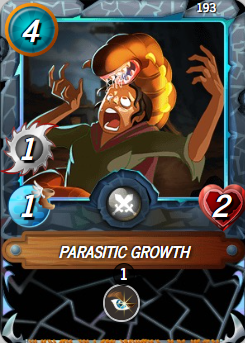Hi all,
Introduction
Another post in this series. Thank you for your support in the previous posts 😊
This series intends to determine if there are other aspects of cards that may contribute to increasing its value. Based on your feedback I can focus on more/other things – so feel free to tell me where you want me to go into further detail.
I include some analysis on where the cards fit in terms of gameplay, strategy, comparison with other cards, and a market analysis of its price. Feel free to suggest what more do you want me to look into in this series, and your support is much appreciated!
In this edition I will be looking at the Parasitic Growth.

Gameplay Analysis
Parasitic Growth is a Common Neutral Melee Monster from the Untamed set in Splinterlands. With its Opportunity ability, it excels at picking off weak enemies, and at higher levels, its Scavenger ability allows it to grow stronger as Monsters die.
Mana Cost: 3
Attack Type: Melee
Abilities by Level
Level 1: Opportunity (Targets the enemy Monster with the lowest health, making it an excellent disruptor and finisher)
Level 6: Scavenger (Gains +1 max health whenever any Monster dies, making it more durable in longer battles)
Level-Based Insights
Level 1: Opportunity makes it ideal for eliminating low-health enemies, working well in aggressive melee teams.
Level 6: Scavenger provides scaling survivability, making Parasitic Growth stronger over time, especially in high-death matches.
Comparative Analysis
How does this card compare to other similar ones?
Vs. Uraeus (Neutral): Uraeus has Sneak instead of Opportunity and provides Poison, making it better at directly targeting the backline.
Vs. Silent Sha-Vi (Death): Silent Sha-Vi has higher speed and damage but lacks Scavenger, making Parasitic Growth better in prolonged fights.
Vs. Stitch Leech (Life): Stitch Leech has Life Leech, which provides sustain, whereas Scavenger allows Parasitic Growth to scale more effectively in chaotic battles.
Key Takeaway
Parasitic Growth is a low-cost, aggressive melee Monster with Opportunity and Scavenger, making it ideal for targeting weak enemies while gaining health as units die.
Synergies
Tarsa (Fire Summoner): Increases Melee attack and health, making Parasitic Growth hit harder and last longer.
Byzantine Kitty (Dragon Summoner): Provides Speed and Tank Heal, helping Parasitic Growth survive.
Lurker or Taunt Tanks: Works well with taunt units, as it can eliminate backline threats while tanks absorb damage.
Scavenger Units (Corpse Fiend, Carrion Shade, etc.): Multiple Scavenger Monsters together can snowball into high-health threats.
Ruleset Performance
✅ Favorable Rulesets:
Little League: Low mana cost makes it a great pick.
Equal Opportunity: Synergizes perfectly, ensuring it always targets weaker enemies.
Noxious Fumes: Scavenger allows it to survive longer as Monsters die from Poison.
❌ Challenging Rulesets:
Reverse Speed: Its moderate speed can be a liability.
Fog of War: Disables Opportunity, making it rely on basic melee attacks.
Unprotected: Reduces survivability since armor is removed, making it more vulnerable.
Market Analysis
Price Overview
Regular Foil: around $ 0.09
Gold Foil: around $ 0.56
Investment Potential
Parasitic Growth is a budget-friendly yet highly effective Opportunity Monster. At higher levels, Scavenger makes it a strong scaling threat, ensuring long-term value in high-death matches.
Ratings
Usefulness: 8/10 (Great for melee-based teams and long fights but lacks sustain outside of Scavenger)
Cost-Effectiveness: 9/10 (Affordable and useful in multiple strategies)
Versatility: 7.5/10 (Excels in Opportunity-focused metas but struggles in ranged/magic-heavy battles)
Conclusion
Parasitic Growth is a low-mana, high-impact Monster that becomes stronger as battles progress. If you're looking for a cheap, aggressive melee attacker with scaling potential, it’s a solid addition to your deck.
What do you think about this card? Do you use it in your lineups? Share your experiences in the comments and let me know which card you'd like me to analyze next!
Thank you for your continued support and engagement. 😊